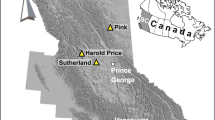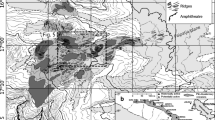Abstract
Hummocks are topographic features of large landslides and rockslide-debris avalanches common in volcanic settings. We use scaled analog models to study hummock formation and explore their importance in understanding landslide kinematics and dynamics. The models are designed to replicate large-scale volcanic collapses but are relevant also to non-volcanic settings. We characterize hummocks in terms of their evolution, spatial distribution, and internal structure from slide initiation to final arrest. Hummocks initially form by extensional faulting as a landslide begins to move. During motion, individual large blocks develop and spread, creating an initial distribution, with small hummocks at the landslide front and larger ones at the back. As the mass spreads, hummocks can get wider but may decrease in height, break up, or merge to form bigger and long anticlinal hummocks when confined. Hummock size depends on their position in the initial mass, modified by subsequent breakup or coalescence. A hummock has normal faults that flatten into low-angle detachments and merge with a basal shear zone. In areas of transverse movement within a landslide, elongate hummocks develop between strike–slip flower structures. All the model structures are consistent with field observations and suggest a general brittle-slide emplacement for most landslide avalanches. Absence of hummocks and fault-like features in the deposit may imply a more fluidal flow of emplacement or very low cohesion of lithologies. Hummocks can be used as kinematic indicators to indicate landslide evolution and reconstruct initial failures and provide a framework with which to study emplacement dynamics.









Similar content being viewed by others
References
Afrouz AA (1992) Practical handbook of rock mass classification systems and modes of ground failure. CRC, London
Andrade D, van Wyk de Vries B (2010) Structural analysis of the early stages of catastrophic stratovolcano flank-collapse using analogue models. Bull Volcanol 72:771–789. doi:10.1007/s00445-010-0363-x
Bell FG (2000) Engineering properties of soils and rocks, 4th edn. Blackwell, Oxford
Bernard B, van Wyk de Vries B, Leyrit H (2009) Distinguishing volcanic debris avalanche deposits from their reworked products: the Perrier sequence (French Massif Central). Bull Volcanol 71:1041–1056. doi:10.1007/s00445-009-0285-7
Brun J-P, Choukroune P (1983) Normal faulting, block tilting, and décollement in a stretched crust. Tectonics 2(4):345–356
Campbell CS (1989) Self-lubrication for long runout landslides. J Geolog 97:653–665
Campbell CS, Cleary PW, Hopkins MJ (1995) Large-scale landslide simulations: global deformation, velocities and basal friction. J Geophys Res 100:8267–8283. doi:10.1029/94JB00937
Cecci E, van Wyk de Vries B, Lavest J-M (2005) Flank spreading and collapse of weak-cored volcanoes. Bull Volcanol 67:72–91. doi:10.1007/s00445-004-0369-3
Clavero JE, Sparks RSJ, Huppert HE (2002) Geological constraints on the emplacement mechanism of the Parinacota avalanche, northern Chile. Bull Volcanol 64:40–54
Crandell DR (1989) Gigantic debris avalanche of Pleistocene age from ancestral Mount Shasta Volcano, California, and debris-avalanche hazard zonation. US Geolog Survey Bull 1861:31
Dade WB, Huppert HE (1998) Long run-out rockfalls. Geology 26:803–806
Delcamp A, van Wyk de Vries B, James MR (2008) The influence of edifice slope and substrata on volcano spreading. J Volcanol Geotherm Res 177(4):925-943. http://dx.doi.org/10.1016/j.jvolgeores.2008.07.014
Denlinger RP, Iverson RM (2001) Flow of variably fluidized granular masses across three-dimensional terrain. 2. Numerical predictions and experimental tests. J Geophys Res 106(B1):553–566. doi:10.1029/2000JB900330
Donnadieu F, Merle O (1998) Experiments on the indentation process during cryptodome intrusions: new insights into Mount St. Helens deformation. Geology 26:79–82
Dufresne A (2009) The influence of runout path material on rock and debris avalanches: field evidence and analogue modeling. Dissertation, Canterbury University, Canterbury
Dufresne A, Davies TR (2009) Longitudinal ridges in mass movement deposits. Geomorphology 105:171–181
Eppler DB, Fink J, Fletcher R (1987) Rheologic properties and kinematics of emplacement of the Chaos Jumbles rockfall avalanche, Lassen Volcanic National Park, California. J Geophys Res 92:3623–3633
Francis PW, Gardeweg M, Ramirez CF, Rothery DA (1985) Catastrophic debris avalanche deposit of Socompa volcano, northern Chile. Geology 13:600–603
Glicken H (1986) Rockslide debris-avalanche of May 18, 1980, Mount St. Helens volcano. Dissertation, University of California, Santa Barbara
Glicken H (1991) Sedimentary architecture of large volcanic-debris avalanches. In: Fisher RV, Smith GA (eds) Sedimentation in volcanic settings. SEPM Special Publication 45: pp 99-106
Glicken H (1996) Rockslide-debris avalanche of May 18, 1980, Mount St. Helens Volcano, Washington. US Geol Surv Open-File Rep 96–0677:1–90
Iverson RM, Denlinger RP (2001) Flow of variably fluidized granular masses across three-dimensional terrain. 1. Coulomb mixture theory. J Geophys Res 106(B1):537–552. doi:10.1029/2000JB003758
Kelfoun K, Druitt T (2005) Numerical modeling of the emplacement of Socompa rock avalanche, Chile. J Geophys Res 110:B12202. doi:10.1029/2005JB003758
Kelfoun K, Druitt T, van Wyk de Vries B, Guilbaud M-N (2008) Topographic reflection of the Socompa debris avalanche, Chile. Bull Volcanol 70:1169–1187. doi:10.1007/s00445-008-0201-6
Lagmay AMF, van Wyk de Vries B, Kerle N, Pyle DM (2000) Volcano instability induced by strike–slip faulting. Bull Volcanol 62:331–346. doi:10.1007/s004450000103
Lucchitta BK (1979) Landslides in Valles Marineris. J Geophys Res 84:8097–8113
Mathieu L, van Wyk de Vries B (2011) The impact of strike–slip, transtensional and transpressional fault zones on volcanoes. Part I: scaled experiments. J Structural Geol. doi:10.1016/j.jsg2011.03.002
Paguican EMR (2012) The structure, morphology, and surface texture of debris avalanche deposits: field and remote sensing mapping and analogue modelling. Dissertation, Université Blaise Pascal, Clermont-Ferrand
Paguican EMR, van Wyk de Vries B, Lagmay AMF (2011) Hummocks in large avalanches: how they form and what they mean. Geophys Res Abstract. Vol. 13, EGU2011-3437
Paguican EMR, van Wyk de Vries B, Lagmay AMF (2012) Volcano-tectonic controls and emplacement kinematics of the Iriga debris avalanches (Philippines). Bull Volcanol 74(9):2067–2081. doi:10.1007/s00445-012-0652-7
Palmer AB, Alloway BV, Neall VE (1991) Volcanic debris avalanche deposits in New Zealand—lithofacies organization in unconfined wet-avalanche flows. In: Fisher RV, Smith GA (eds) Sedimentation in volcanic settings. SPEM Special Publication 45, pp 89–98
Pouliquen O, Renaut N (1996) Onset of granular flows on an inclined rough surface: dilutancy effects. J Physique II 6:929–935. doi:10.1051/jp2:1996220
Shea T, van Wyk de Vries B (2008) Structural analysis and analogue modeling of the kinematics and dynamics of rockslide avalanches. Geosphere 4(4):657–686. doi:10.1130/GES00131.1
Shea T, van Wyk de Vries B, Pilato (2008) Emplacement mechanism of contrasting debris avalanches at Volcan Mombacho (Nicaragua), provided by structural and facies analysis. Bull Volcanol 70:899–921. doi:10.1007/s00445-007-0177-7
Siebert L (1984) Large volcanic debris avalanches: characteristics of source areas, deposits, and associated eruptions. J Volcanol Geotherm Res 22:163–197
Siebert L, Beget JE, Glicken H (1995) The 1883 and late prehistoric eruptions of Augustine volcano, Alaska. In: Ida Y, Voight B (eds) Models of magmatic processes and volcanic eruptions. J Volcanol Geotherm Res 66, pp 367-395
Sousa J, Voight B (1995) Multiple-pulsed debris avalanche emplacement at Mount St. Helens in 1980: evidence from numerical continuum flow simulations. J Volcanol Geotherm Res 66:227–250
Staron L, Vilotte JP, Radjai F (2001) Friction and mobilization of contacts in granular numerical avalanches. In: Kishino Y (ed) Powders and grains. Swets and Zeitlinger, Lisse, pp 451–454
Takarada S, Ui T, Yamamoto Y (1999) Depositional features and transportation mechanism of valley-filling Iwasegawa and Kaida debris avalanches, Japan. Bull Volcanol 60:508–522
Thompson N, Bennet MR, Petford N (2010) Development of characteristic volcanic debris avalanche deposit structures: new insights from distinct element simulations. J Volcanol Geotherm Res 192:191–200. doi:10.1016/j.volgeores.2010.02.021
Ui T (1983) Volcanic dry avalanche deposits—identification and comparison with non-volcanic debris stream deposits. J Volcanol Geotherm Res 18:135–150
Ui T, Glicken H (1986) Internal structural variations in a debris-avalanche deposit from ancestral Mount Shasta, California, USA. Bull Volcanol 48:189–194
van Wyk de Vries B, Francis PW (1997) Catastrophic collapse at stratovolcanoes induced by gradual volcano spreading. Nature 387:387–390
van Wyk de Vries B, Kerle N, Petley D (2000) Sector collapse forming at Casita volcano, Nicaragua. Geology 28:167–170
van Wyk de Vries B, Self S, Francis PW, Keszthelyi L (2001) A gravitational spreading origin for the Socompa debris avalanche. J Volcanol Geotherm Res 105:225–227
Vidal N, Merle O (2000) Reactivation of basement faults beneath volcanoes: a new model of flank collapse. J Volcanol Geotherm Res 99:9–26
Voight B, Glicken H, Janda RJ, Douglas PM (1981) Catastrophic rockslide avalanche of May 18. In: Lipman PW, Mullineaux DR (eds) The 1980 eruptions of Mount St. Helens, Washington. US Geol Surv Prof Pap 1250:347-377
Voight B, Glicken H, Janda RJ, Douglass PM (1983) Nature and mechanics of the Mount St Helens rockslide-avalanche of 18 May 1980. Geotechnique 33:243–273
Wadge G, Francis PW, Ramirez CF (1995) The Socompa collapse and avalanche event. In: Ida Y, Voight B (eds) Models of magmatic processes and volcanic eruptions. J Volcanol Geotherm Res 66, pp 309-336
Williams DL, Abrams G, Finn C, Dzurisin D, Johnson DJ, Denlinger R (1987) Evidence from gravity data for an intrusive complex beneath Mount St. Helens. J Geophys Res 92:10207–10222
Wooller L, van Wyk de Vries B, Murray JB, Rymer H, Meyer S (2004) Volcano spreading controlled by dipping substrata. Geology 32(7):573–576. doi:/10.1130/G20472.1
Yoshida H, Sugai T, Ohmori H (2012) Size–distance relationships for hummocks on volcanic rockslide-debris avalanche deposits in Japan. Geomorphology 136(1):76–87. doi:10.1016/j.geomorph.2011.04.044, ISSN 0169-555X
Acknowledgments
This study is a result of the cotutelle Ph.D. program between the Université Blaise Pascal and the University of the Philippines. Funding was provided by the French Embassy in Manila and the EIFFEL Excellence Scholarship.
Author information
Authors and Affiliations
Corresponding author
Electronic supplementary material
Below is the link to the electronic supplementary material.
ESM 1
Chosen analogue models that best represent the recurrent morphology and structures in the three sets of experiments: Set 1, Set 2, and set 3 with their classified avalanche classes and the type of hummocks formed in each of the classes. (TIFF 169722 kb)
ESM 2
Line plot of the hummock sizes sorted according to its distance away from the source. (TIFF 167086 kb)
Rights and permissions
About this article
Cite this article
Paguican, E.M.R., van Wyk de Vries, B. & Lagmay, A.M.F. Hummocks: how they form and how they evolve in rockslide-debris avalanches. Landslides 11, 67–80 (2014). https://doi.org/10.1007/s10346-012-0368-y
Received:
Accepted:
Published:
Issue Date:
DOI: https://doi.org/10.1007/s10346-012-0368-y




